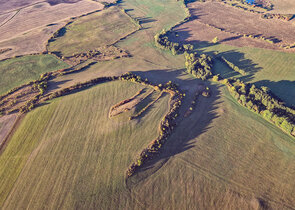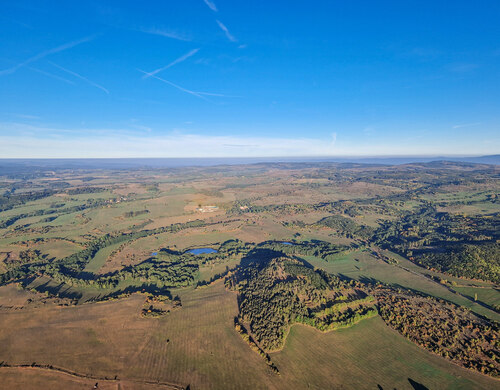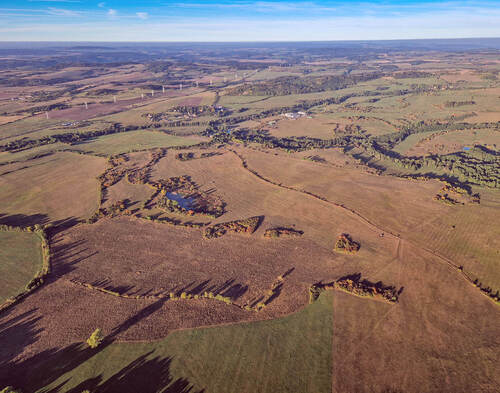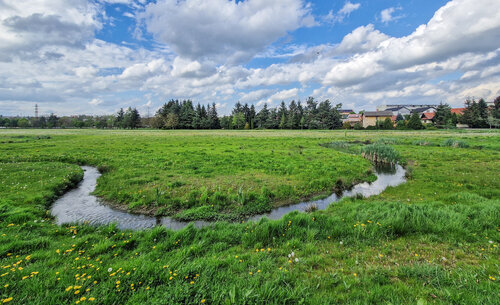Nature Conservation 2025 — 31. 7. 2025 — Nature and Landscape Management — Print article in pdf
Landscape Policy of the Czech Republic

In the Czech Republic there may seem to be a wide range of conceptual, strategic and other documents focused – either primarily or as part of a broader spectrum of interests – on nature conservation and landscape protection.
These include international documents such as the Global Biodiversity Framework, the European Landscape Convention, and the Nature Restoration Regulation, which is hopefully nearing final approval and will serve as the basis for the National Nature Restoration Plan.
Among national documents, the most prominent include the Strategy on Adaptation to Climate Change in the Czech Republic, the related National Action Plan for Adaptation to Climate Change, and the National Biodiversity Strategy of the Czech Republic. Assessing the success of implementing these documents and their objectives as well as the effectiveness of the measures taken would be a topic for a separate article – or even several. However, when looking at the Czech Republic’s landscape on a broader scale, the picture is far from encouraging. Although a number of local improvements can be found – resulting from various types of restoration measures or shifts towards more nature-friendly forestry and agricultural practices – the overall state of the landscape is not improving; if anything, it is deteriorating.

For successful adaptation to ongoing climate change, it is essential to protect existing natural systems due to their inherent ability to withstand extreme fluctuations such as droughts or floods. © Linda Stuchlíková
The landscape in the Czech Republic as a whole is overly homogeneous, lacking features that would enhance its ecological stability, help retain greater volumes of water, and prevent or at least mitigate soil erosion. There has been a long-term decline in biodiversity at all its levels. The condition and resilience of the landscape and its individual components are such that they are easily susceptible to negative external influences (drivers). A prime example of this was the European spruce bark beetle outbreak (Ips typographus) in forests a few years ago, which clearly demonstrated that adaptation to climate change is not a long-term vision, but an immediate necessity. It is essential not only to maintain and enhance landscape stability and health, but also to prepare it for a range of difficult-to-predict events related to ongoing and probably accelerating climate change, as well as for a number of new demands on land use. It is also necessary to mention the expected unprecedented development of renewable energy sources, associated with the planned transition to a carbon-free economy in the coming decades.

Individual components of the landscape – agricultural, forest, aquatic ecosystems, human settlements and technical infrastructure – should be balanced and coexist in synergy. © Linda Stuchlíková
Origins and emergence of landscape policy
The demand for landscape planning has been evident for a long time. However, views differ on what exactly this term entails. Opinions are polarized, ranging from the idea of an all-encompassing, almost idyllic resolution of conflicts between economic interests in the land and those of nature conservation and landscape protection, to the strengthening and enhancement of expertise in land-use/territorial spatial planning tools, all the way to a more sceptical view that sees landscape planning as just another study for the study.
The Ministry of the Environment of the Czech Republic (MoE) is aware of its role in the strategic and methodological grounding of landscape planning. Tasks aimed at defining this concept are already included in the above National Adaptation Strategy approved by the Government. The connection with the European Landscape Convention, which the Czech Republic signed in 2002 and which came into force in 2004 is also clear. Each contracting party to the Convention commits to introducing and implementing landscape policies focused on the landscape protection, management, and planning.
To achieve sufficient technical/expert support and capacity, the MoE has included the topic of landscape planning in the reforms of the National Recovery Plan, which is a European Union’s economic instrument designed for reforms and investments in its Member States to revive the economy after the COVID-19 pandemic and to support green and digital transformation. The reform activity in the National Recovery Plan – preparation of the Landscape Policy strategic document – was approved by the Government in Decree No. 437 on June 14, 2023. A wide range of expert institutions is collaborating with the MoE on the preparation of the Landscape Policy, particularly the Nature Conservation Agency of the Czech Republic, the Silva Tarouca Research Institute for Landscape and Ornamental Gardening (now the Research Institute for Landscape), as well as CzechGlobe, the Global Change Research Institute of the Czech Academy of Sciences.

Restoration of the Rokytka Rivulet in Prague – a natural floodplain with active retention – an area designated for the harmless overflow of high water which, conversely, slowly drains from the floodplain during dry periods. © Linda Stuchlíková
Intensive preparation of the document began at the start of 2024. Six expert working groups were established to develop the supporting materials (Biodiversity, Water, Forestry, Agriculture, Settlements and Culture, Infrastructure). The working groups were composed not only of MoE staff but also of representatives from other ministries, various research institutions, non-governmental organisations, and business associations, ensuring a broad range of opinions within the groups and that all significant and legitimate interests related to land use were considered. In the first phase of preparing the Landscape Policy, its analytical part will be developed, which will describe problems and challenges within the landscape. This will be followed by the proposal part, with the outcome of the definition of specific goals and tools for effective planning and use of the landscape in the Czech Republic.
The above-mentioned reform under the National Recovery Plan is to be completed by 2026 at the latest. However, it is expected that the Landscape Policy document will be approved by the current Government through its resolution as a Decree, as it was this Government that commissioned it from the MoE by the Decree already referred to. Approval should therefore ideally take place no later than autumn 2025. Before final approval of the entire document, a public consultation process is also planned.
Landscape policy objectives
The aim of the Landscape Policy is not to create new tools for landscape planning, but rather to identify the landscape’s priority needs and assess existing tools for achieving them. It has long been evident that the main problems facing the landscape in the Czech Republic do not lie in the absence of such tools, but rather in their suboptimal design and, consequently, inefficiency of their use. In this context, we can mention tools from the framework of several legal regulations. Under the Act on Nature Conservation and Landscape Protection, a Territorial System of Ecological Stability (TSES), i.e. multi-level ecological network across the whole country, is defined, which still plays an irreplaceable role in nature conservation and landscape protection. However, it needs to be better aligned with current scientific knowledge, as well as with the evolving demands on land use mentioned earlier. The same applies to Significant Landscape Elements (SLEs), which can undoubtedly be regarded as a key tool for the general area-based protection and conservation of nature and the landscape. However, its application in practice often shows shortcomings, partly due to insufficient methodological guidance from the MoE. Tools of other ministries also play an important role in landscape planning, particularly those of the Ministry of Regional Development of the Czech Republic and the Ministry of Agriculture of the Czech Republic. The MoE considers land-use/territorial or spatial planning tools to be absolutely essential. An example of successful cooperation between the two ministries can be seen in the development of a methodology for the application of spatial landscape studies, which can currently be funded for the administrative districts of municipalities with extended powers under the Operational Programme Environment. Better methodological guidance is certainly warranted for the concept of landscape organisation as part of land-use/territorial or spatial plans. In addition to the mentioned land-use/territorial or spatial planning tools, tools from the Ministry of Agriculture will also be analysed, e.g. comprehensive land replotting/land consolidation or reparcelling, interventions and conditions of the Common Agricultural Policy, and forestry planning.
Landscape planning methodology
The development and elaboration of the Landscape Policy should be immediately followed by the development of the Landscape Planning Methodology. It should not be an action plan for Landscape Policy, but rather a guide for the effective use of planning tools, land use, conservation, and landscape management in practice. For this tool to be practical and effective, it will be necessary to link it with existing frameworks, or possibly modified ones, provided by specific legal regulations. The focus there will primarily be on the necessary connection with the above land-use/territorial or spatial planning documents. The term landscape planning has been appearing in various technical/expert documents for some time; however, it has not yet been clearly methodologically defined and, most importantly, connected with legislative tools. Therefore, one of the key tasks of landscape planning will thus be linking documents of different hierarchical levels, which currently does not function optimally in practice.
Connections with other strategies
Currently, other strategic documents in nature conservation and landscape protection are being prepared, or are starting to be prepared. In connection with the expected approval of the Nature Restoration Regulation, preparation of the National Restoration Plan (NRP) should also begin in the near future. This will be a tool whose foundations will be shared in certain areas with the Landscape Policy, particularly in the topics of biodiversity conservation. The difference between the two documents will primarily be in the specific scope, with the NRP proposing implementation of specific indicators according to the individual articles that the Nature Restoration Regulation directly mandates for EU Member States, or which Member States choose from a broader set of indicators. Together with the Landscape Policy, an update of the Biodiversity Conservation Strategy is also being prepared, which is expected to be valid from 2026. The preparation of such a large number of documents will certainly be challenging, and great emphasis will need to be placed on optimally linking them.
Landscape planning as a broad discussion
We cannot expect the Landscape Policy document on its own to solve all the problems, difficulties and challenges of the landscape in the Czech Republic; at the same time, we do not want to have a wishful thinking strategy, which we will, at most, distribute at seminars in an effort to spread goodwill. The Landscape Policy is being developed in cooperation of ministries, will be approved by the Government of the Czech Republic, and may thus assign specific tasks to individual ministries. The MoE is guided by the aim to foster a constructive debate with economic sectors during the development of the Policy and to strengthen the role of tools that will help align the interests of nature conservation and landscape protection with those of its economic use. We live in the human-modified, cultural landscape, and in the context of ongoing climate change and its negative impacts, the role of natural systems has been becoming increasingly important. The protection and conservation of existing aquatic and terrestrial ecosystems as well as the restoration of those damaged into naturally stable and resilient ones is key to reducing the vulnerability of landscape and its economic use in the Czech Republic. ■
- - - -
Cover photo: Farmland/agricultural landscape structured by landscape elements is key to sustainable land management and biodiversity conservation. © Linda Stuchlíková
- - - -
The list of references is attached to the online version of the article at www.casopis.ochranaprirody.cz

